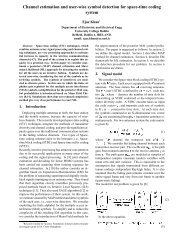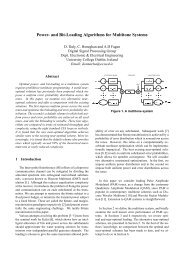Maximum likelihood detection of MIMO system using second order ...
Maximum likelihood detection of MIMO system using second order ...
Maximum likelihood detection of MIMO system using second order ...
Create successful ePaper yourself
Turn your PDF publications into a flip-book with our unique Google optimized e-Paper software.
6. CONCLUSIONSIn this paper, we proposed a new ML <strong>detection</strong> method for the<strong>MIMO</strong> channel. This method is based on relaxing the MAX-CUT problem and solving the resulting <strong>system</strong> by SOCP. We haveshown that the MAX-CUT (equivalently ML <strong>detection</strong>) problemcan be formulated into SOCP problem. The advantage <strong>of</strong> the proposedmethod over the SDP relaxation is that the difference in thenumber <strong>of</strong> variables between SDP relaxation and SOCPas£increasesbecomes large. Hence MAX-CUT SOCP is numerically moreefficient. Although, in general, the lower bound computed bySOCP relaxation is not as good as a bound obtained with SDPrelaxation in theory, they are <strong>of</strong>ten close to each other [6]. Theproposed method has three significant advantages over the spheredecoding technique.1) The proposed method is polynomial time irrespective <strong>of</strong> thevalue <strong>of</strong> the SNR as opposed to sphere decoding which has exponentialcomplexity for low SNR values.2) The SOCP has no heuristic parameters to set (unlike the spheredecoder in which the optimal radius has to be selected in a heuristicway).3) The sphere decoder complexity,¢¡¤£ ¥ , is at each time instant,while there is no such problem in SOCP approach.Moreover our approach does not require number <strong>of</strong> the receive antennasto be greater than number <strong>of</strong> the transmit antennas as theBLAST receiver does. Simulations results in figure 2 shows thatSOCP gives very close approximation to the exact ML and thatthere is almost no difference between the performance <strong>of</strong> the SDPand SOCP method. Simulations are performed for two transmitand two receive antennas. In general for large£the saving <strong>of</strong> CPUtime gets larger for SOCP in comparison to SDP method.[2] G.J. Foschini, ”Layered space-time architecture for wirelesscommunication in a fading environment when <strong>using</strong> multielementantenna ”, Bell labs Tech. Journal, vol.1, no.2, pp.41-59, 1996.[3] H. Vikalo and B. Hassibi, ”<strong>Maximum</strong> <strong>likelihood</strong> sequence <strong>detection</strong>for multiple antenna <strong>system</strong> over dispersive channelsvia sphere decoding ”, Eurasip Journal on App. Signal Processing, no.5, pp.525-531, May, 2002.[4] M.X. Goemans and D.P. Williamson, ”Improved approximationalgorithms for maximum cut and satisfiability problems<strong>using</strong> semidefinite programming ” Int. Journal <strong>of</strong> ACM, no.42,pp.1115-1145, 1995.[5] B. Mohar and S. Poljak, ”Eigenvalues and max-cut problem”Czechoslavak mathematical journal, no.40, pp.343-352, 1990.[6] S. Kim and M. Kojima, ”Second <strong>order</strong> cone programming relaxation<strong>of</strong> non-convex quadratic optimization problems” Optimizationmethods and s<strong>of</strong>tware no.15, pp.201-224, 2001.[7] M.S. Lobo, L. Vandenberghe, S. Boyd and H. Lebret, ”Applications<strong>of</strong> <strong>second</strong> <strong>order</strong> cone programming, Tech. report January31, 1998.[8] C. Helmberg and F. Rendl , ”Solving quadratic (0,1) problemsby semidefinite programs and cutting planes”, Mathematicalprogramming, vol.82, pp. 219-315, 1998.[9] M. Junger and G. Rinaldi, ”Relaxation <strong>of</strong> Max-Cut problemand computations <strong>of</strong> spin glass ground states”, Tech. reportno. 97.300, 1997.[10] Y. E. Nesterov and A. S. Nemirovskii, ”Interior point polynomialalgorithms in convex programming”, SIAM studies inApplied Mathematics, SIAM, Philadelphia, PA, 1994. .10 0BER versus SNRexact MLSDP MLSOCP ML10 −1BER10 −210 −310 −40 0.5 1 1.5 2 2.5 3 3.5 4 4.5 5SNR in dBFig. 2. Av. BER for N=2, M=2 vs ¢¡¤£¦¥¨§©¦ .7. REFERENCES[1] I.E. Talatar, ”Capacity <strong>of</strong> multi-antenna Gaussian channels ”,European Trans. on Telecommunications, vol.6,no., pp.585-595, no.11, 1999.




